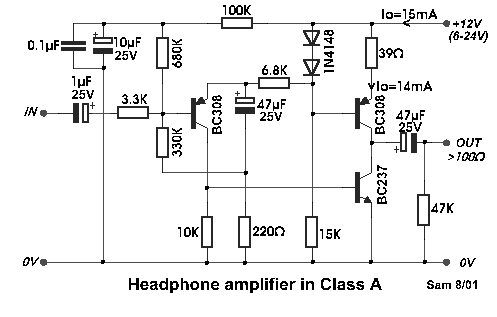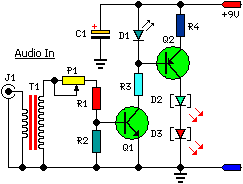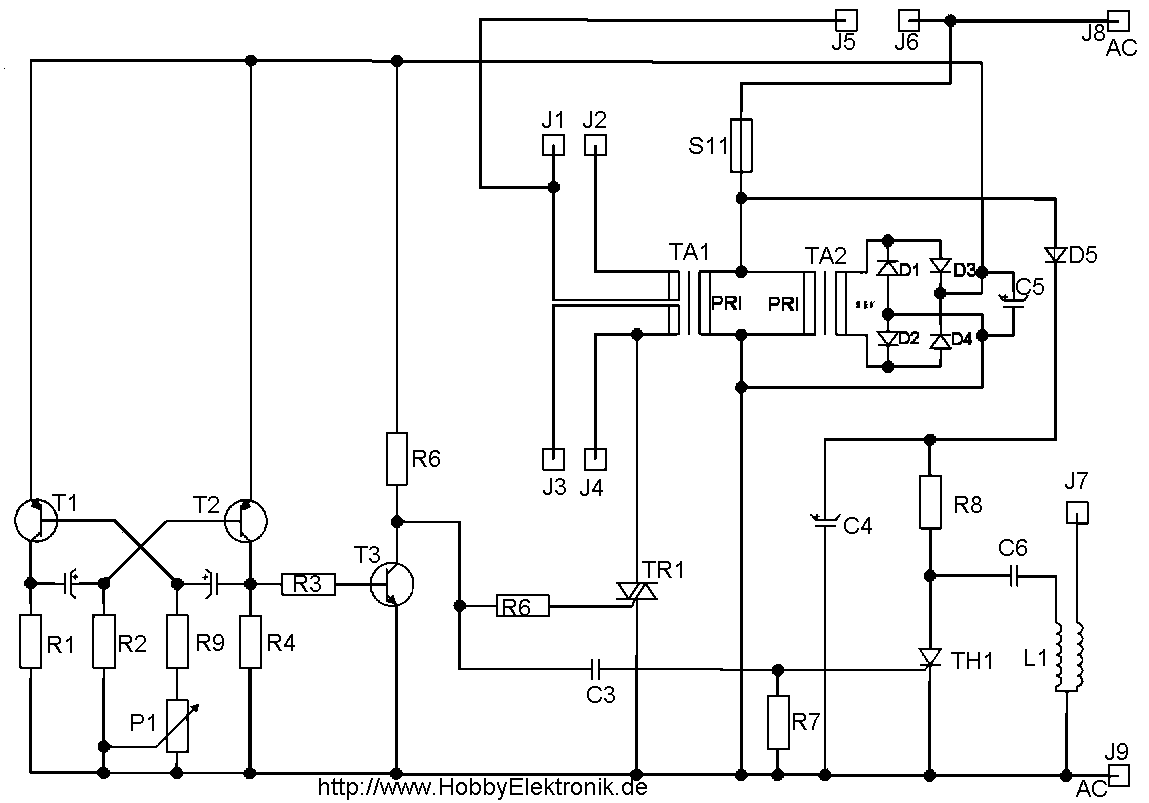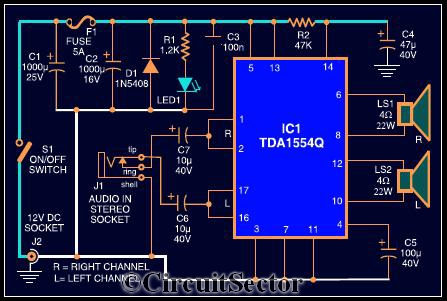
555 Low power Consumption Timer Circuit
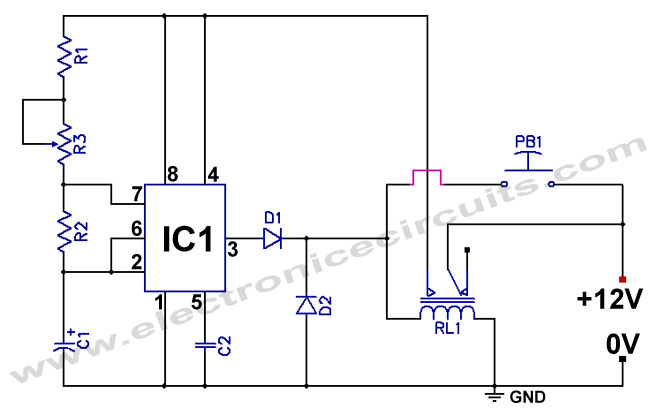
The standard 555 timer circuit consumes power from the battery even when the start push-button (PB1) is not pressed, due to a potential divider created by three 5kΩ resistors within the integrated circuit (IC). This power consumption, referred to as idling power consumption, is approximately 3mA. If the circuit remains connected to a battery for an extended period, it can drain the battery and potentially lead to unreliable operation. To address this issue, an alternative circuit is proposed that allows power to be drawn from the battery only during the timing action. During the idle periods, power consumption is effectively zero. The circuit incorporates a double-pole relay; one pole is responsible for energizing the load, while the other pole disconnects the supply line once the timing action is completed. When the start switch is pressed, the relay (RL1) is energized. One pair of contacts from the relay supplies voltage to the timer, triggering it. Oscillations commence, and when the output at pin 3 goes HIGH, diode D1 allows current to flow through the relay, latching it in the energized state. The frequency of oscillations is determined by the time constant T = 1.1G—C1G—(R1 + R3). Once the timing period concludes, the output at pin 3 goes LOW, the relay is released, and the load is de-energized.
The circuit design utilizes a 555 timer in astable mode, which is a common configuration for generating a continuous square wave output. The inclusion of a double-pole relay enhances the functionality by allowing for efficient power management. The relay contacts are strategically used to control the power supply to both the timer and the load, ensuring that energy is conserved during idle periods. The push-button switch (PB1) serves as the user interface to initiate the timing sequence.
The resistor values and capacitor used in the timing circuit are critical for defining the oscillation frequency. The time constant formula indicates that the timing period can be adjusted by varying the values of R1, R3, and C1. This flexibility allows for customization of the timing intervals based on the specific application requirements.
The diode D1 is essential for ensuring that once the relay is energized, it remains latched until the timing cycle is complete. This prevents the relay from dropping out prematurely and ensures that the load remains powered throughout the duration of the timing operation.
Overall, this circuit design not only addresses the idling power consumption issue associated with traditional 555 timer circuits but also provides a practical solution for applications where battery life is a concern. By implementing this design, the reliability and efficiency of the circuit are significantly improved, making it suitable for various electronic projects.Normally 555 timer circuit even though the start push-button PB1 is not pressed, the timer keeps consuming power From the battery due to a potential divider formed by three 5k © resistors within the IC. this power consumption known as the idling power consumption of the timer is about 3mA. This, if left connected to a battery for a long time can drain off the battery and may give unreliable operation. To deviate this short coming, you may use the circuit given in the below. Which enables power to be drained from the battery only when timing action is ON. For the idling period, the power consumption is zero. The circuit uses a double pole relay. One pole is used to energize the load, the other pole is used to cut off the supply line when the timing action is over. A push on the Start` switch energizes the relay RL1. A pair of contacts of the relay provides the supply voltage to the timer which get triggered. Oscillations start and when the output at pin 3 becomes HIGH, the diode D1 permits current to flow through the relay, thus latching it up.
The frequency of the oscillations depends on the time constant given by T=1. 1G—C1G—(R1 R3). After this time is over, the output at pin 3 goes LOW; the relay is released, and the load is de-energized. We aim to transmit more information by carrying articles. Please send us an E-mail to wanghuali@hqew. net within 15 days if we are involved in the problems of article content, copyright or other problems.
We will delete it soon. 🔗 External reference
The circuit design utilizes a 555 timer in astable mode, which is a common configuration for generating a continuous square wave output. The inclusion of a double-pole relay enhances the functionality by allowing for efficient power management. The relay contacts are strategically used to control the power supply to both the timer and the load, ensuring that energy is conserved during idle periods. The push-button switch (PB1) serves as the user interface to initiate the timing sequence.
The resistor values and capacitor used in the timing circuit are critical for defining the oscillation frequency. The time constant formula indicates that the timing period can be adjusted by varying the values of R1, R3, and C1. This flexibility allows for customization of the timing intervals based on the specific application requirements.
The diode D1 is essential for ensuring that once the relay is energized, it remains latched until the timing cycle is complete. This prevents the relay from dropping out prematurely and ensures that the load remains powered throughout the duration of the timing operation.
Overall, this circuit design not only addresses the idling power consumption issue associated with traditional 555 timer circuits but also provides a practical solution for applications where battery life is a concern. By implementing this design, the reliability and efficiency of the circuit are significantly improved, making it suitable for various electronic projects.Normally 555 timer circuit even though the start push-button PB1 is not pressed, the timer keeps consuming power From the battery due to a potential divider formed by three 5k © resistors within the IC. this power consumption known as the idling power consumption of the timer is about 3mA. This, if left connected to a battery for a long time can drain off the battery and may give unreliable operation. To deviate this short coming, you may use the circuit given in the below. Which enables power to be drained from the battery only when timing action is ON. For the idling period, the power consumption is zero. The circuit uses a double pole relay. One pole is used to energize the load, the other pole is used to cut off the supply line when the timing action is over. A push on the Start` switch energizes the relay RL1. A pair of contacts of the relay provides the supply voltage to the timer which get triggered. Oscillations start and when the output at pin 3 becomes HIGH, the diode D1 permits current to flow through the relay, thus latching it up.
The frequency of the oscillations depends on the time constant given by T=1. 1G—C1G—(R1 R3). After this time is over, the output at pin 3 goes LOW; the relay is released, and the load is de-energized. We aim to transmit more information by carrying articles. Please send us an E-mail to wanghuali@hqew. net within 15 days if we are involved in the problems of article content, copyright or other problems.
We will delete it soon. 🔗 External reference
